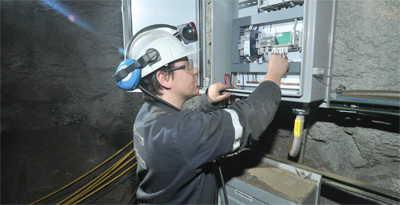 The successful deployment of a ventilation-on-demand system at Vale’s Coleman Mine in Sudbury is generating energy savings of up to 40 per cent and turning heads in the mining industry.
The successful deployment of a ventilation-on-demand system at Vale’s Coleman Mine in Sudbury is generating energy savings of up to 40 per cent and turning heads in the mining industry.
The NRG1-ECO system developed by Bestech, an engineering, automation and software development company in Sudbury, is installed on five levels of the mine’s 153 Orebody and running on automatic, modulating fans and air volumes as RFID-equipped personnel and equipment enter and exit zones in the mine.“The next installation will be done at Goldcorp’s Hoyle Pond Mine in Timmins,” said Bestech sales and marketing manager Pat Dubreuil. “We’ll be working on 28 levels.”
A go-slow approach was adopted for the pilot at Coleman, but now that the technology is proven, Vale plans to extend the system to other working areas of the mine.
A competing system from Quebec-based Simsmart Technologies has been selected for Vale’s new Totten Mine east of Sudbury, but management has declined to comment on how the two technologies compare or if they plan to standardize on one or the other.
Xstrata Nickel has also split its VOD business between the two companies, with Simsmart technology installed at its Nickel Rim Mine and Bestech’s NRG1-ECO system slated for Fraser Mine.
The two ventilation-on-demand technologies are fundamentally different, according to Dubreuil.
The NRG1-ECO system relies on a network of sensors throughout the mine to measure airflow, temperature and gas levels to confirm air volume and quality.
“NRG1-ECO sends down a set point and says you need to have this fan producing so much air in this area because there are two people and three scoops in there,” said Dubreuil. “The system controls the amount of electricity going to that fan, providing the right amount of hertz to get it to spin and provide the desired airflow.”
At the same time, however, the system is also getting feedback from the sensors, so if the environmental conditions change, a signal is sent down to adjust the airflow.
With amendments to Regulation 854 updating diesel exhaust exposure limits and air volume requirements set to take effect in Ontario January 1, 2012, “you need to have a system that is structured like the NRG1-ECO system,” he added.
Scheduling
Collecting ambient air quality data can also be used to fine tune scheduled ventilation settings for vacating blast gas. The predictive modeling software may dictate settings that should clear the air in 15 minutes, but once the event has taken place, data from the underground sensors might indicate that it took 20 minutes, said Dubreuil. “That allows you to tweak the system, so next time you’ll start your fan five minutes earlier or ramp up the RPMs a little more. From a theoretical perspective, you couldn’t do that.”
Ambient air quality measuring can be installed to emulate Bestech’s NRG1-ECO system, but “the difference is that our system was developed from the ground up with all these components. They’re not added on after the fact.”
NRG1-ECO operates in three different modes. “One would be if you want to operate it manually,” explained Cheryl Allen, Vale Canada’s principal engineer for ventilation. “Another is if you want to schedule your ventilation for an event. If you are going to blast at a certain time, for example, you can schedule how you want your fans to turn on or off.
“We also have the option to run it full. That’s where we use the RFID tagging on the equipment and personnel. The system recognizes us and knows that we need so much air, so the fan will stay on until we’re out of the area. It also knows that this is a Toyota with a certain size engine that needs a certain amount of air.
“The other thing we can do is while we’re not using the air on one level, we can use more of it on another level, so it gives us flexibility. We don’t always use it to save energy. Sometimes, we use it because we need to redistribute the air more efficiently.”
NRG1-ECO was also designed to operate in a fail-safe mode using default settings programmed by mine personnel. mount of air.
“If we lose communication for some reason, say the fiber is cut, or something happens, the miners won’t be worried about getting the air they want,” said Dubreuil.
With electricity prices rising and mines going deeper, ventilation-on-demand is sure to take off, predicts Allen.
“There’s a lot of interest in it. A lot of companies are looking to Coleman as an example and are interested in the outcomes.”
www.bestech.com
www.simsmart.com


